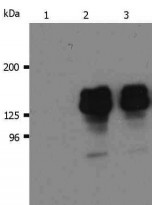ARG63092
anti-SHIP1 antibody [SHIP-01]
anti-SHIP1 antibody [SHIP-01] for Flow cytometry,Western blot and Human
Immune System antibody; Signaling Transduction antibody
Overview
| Product Description | Mouse Monoclonal antibody [SHIP-01] recognizes SHIP1 |
|---|---|
| Tested Reactivity | Hu |
| Tested Application | FACS, WB |
| Specificity | The clone SHIP-01 reacts with SHIP-1, a phosphoinositide phosphatase largely confined to hematopoietic cells. Multiple forms of SHIP-1 have been reported with molecular weights of 110, 125, 130, 135 and 145 kDa. |
| Host | Mouse |
| Clonality | Monoclonal |
| Clone | SHIP-01 |
| Isotype | IgG2a |
| Target Name | SHIP1 |
| Antigen Species | Human |
| Immunogen | Peptide coresponding to a sequence within N-terminal domain of Human SHIP-1. |
| Conjugation | Un-conjugated |
| Alternate Names | EC 3.1.3.86; Inositol polyphosphate-5-phosphatase of 145 kDa; hp51CN; p150Ship; SHIP1; SIP-145; SHIP-1; SH2 domain-containing inositol 5'-phosphatase 1; SH2 domain-containing inositol phosphatase 1; Phosphatidylinositol 3,4,5-trisphosphate 5-phosphatase 1; SHIP |
Application Instructions
| Application Suggestion |
|
||||||
|---|---|---|---|---|---|---|---|
| Application Note | WB: Sample preparation: Resuspend approx. 50 mil. cells in 1 ml cold Lysis buffer (1% laurylmaltoside in 20 mM Tris/Cl, 100 mM NaCl pH 8.2, 50 mM NaF including Protease inhibitor Cocktail). Incubate 60 min on ice. Centrifuge to remove cell debris. Mix lysate with reducing Laemmli SDS-PAGE sample buffer. Boil for 6 min. Application note: Reducing condition. * The dilutions indicate recommended starting dilutions and the optimal dilutions or concentrations should be determined by the scientist. |
||||||
| Positive Control | FACS: Human blood leukocytes WB: Ramos |
Properties
| Form | Liquid |
|---|---|
| Purification | Purified from ascites by protein-A affinity chromatography. |
| Purity | > 95% (by SDS-PAGE) |
| Buffer | PBS (pH 7.4) and 15 mM Sodium azide |
| Preservative | 15 mM Sodium azide |
| Concentration | 1 mg/ml |
| Storage Instruction | For continuous use, store undiluted antibody at 2-8°C for up to a week. For long-term storage, aliquot and store at -20°C or below. Storage in frost free freezers is not recommended. Avoid repeated freeze/thaw cycles. Suggest spin the vial prior to opening. The antibody solution should be gently mixed before use. |
| Note | For laboratory research only, not for drug, diagnostic or other use. |
Bioinformation
| Database Links |
Swiss-port # Q92835 Human Phosphatidylinositol 3,4,5-trisphosphate 5-phosphatase 1 |
|---|---|
| Gene Symbol | INPP5D |
| Gene Full Name | inositol polyphosphate-5-phosphatase, 145kDa |
| Background | SHIP-1 (SH2 domain containing inositol phosphatase-1) is a 5´inositol phosphatase that regulates cell responses in lymphocytes and myeloid cells by hydrolyzing the second messenger PI(3,4,5) trisphosphate. SHIP-1 is recruited upon engagement of both inhibitory and activatory receptors, such as FcgammaRIIB, Fcgamma RIII, FcepsilonRI or cytokine and growth factor receptors, and supresses PI3K-dependent signaling, down-regulates cell migration and invasion of transformed cells and phagocytosis. SHIP-1 also serves as a scaffold for the recruitment of other proteins to the plasma membrane. |
| Function | Phosphatidylinositol (PtdIns) phosphatase that specifically hydrolyzes the 5-phosphate of phosphatidylinositol-3,4,5-trisphosphate (PtdIns(3,4,5)P3) to produce PtdIns(3,4)P2, thereby negatively regulating the PI3K (phosphoinositide 3-kinase) pathways. Acts as a negative regulator of B-cell antigen receptor signaling. Mediates signaling from the FC-gamma-RIIB receptor (FCGR2B), playing a central role in terminating signal transduction from activating immune/hematopoietic cell receptor systems. Acts as a negative regulator of myeloid cell proliferation/survival and chemotaxis, mast cell degranulation, immune cells homeostasis, integrin alpha-IIb/beta-3 signaling in platelets and JNK signaling in B-cells. Regulates proliferation of osteoclast precursors, macrophage programming, phagocytosis and activation and is required for endotoxin tolerance. Involved in the control of cell-cell junctions, CD32a signaling in neutrophils and modulation of EGF-induced phospholipase C activity. Key regulator of neutrophil migration, by governing the formation of the leading edge and polarization required for chemotaxis. Modulates FCGR3/CD16-mediated cytotoxicity in NK cells. Mediates the activin/TGF-beta-induced apoptosis through its Smad-dependent expression. May also hydrolyze PtdIns(1,3,4,5)P4, and could thus affect the levels of the higher inositol polyphosphates like InsP6. [UniProt] |
| Research Area | Immune System antibody; Signaling Transduction antibody |
| Calculated MW | 133 kDa |
| PTM | Tyrosine phosphorylated by the members of the SRC family after exposure to a diverse array of extracellular stimuli such as cytokines, growth factors, antibodies, chemokines, integrin ligands and hypertonic and oxidative stress. Phosphorylated upon IgG receptor FCGR2B-binding. |
Images (1) Click the Picture to Zoom In








